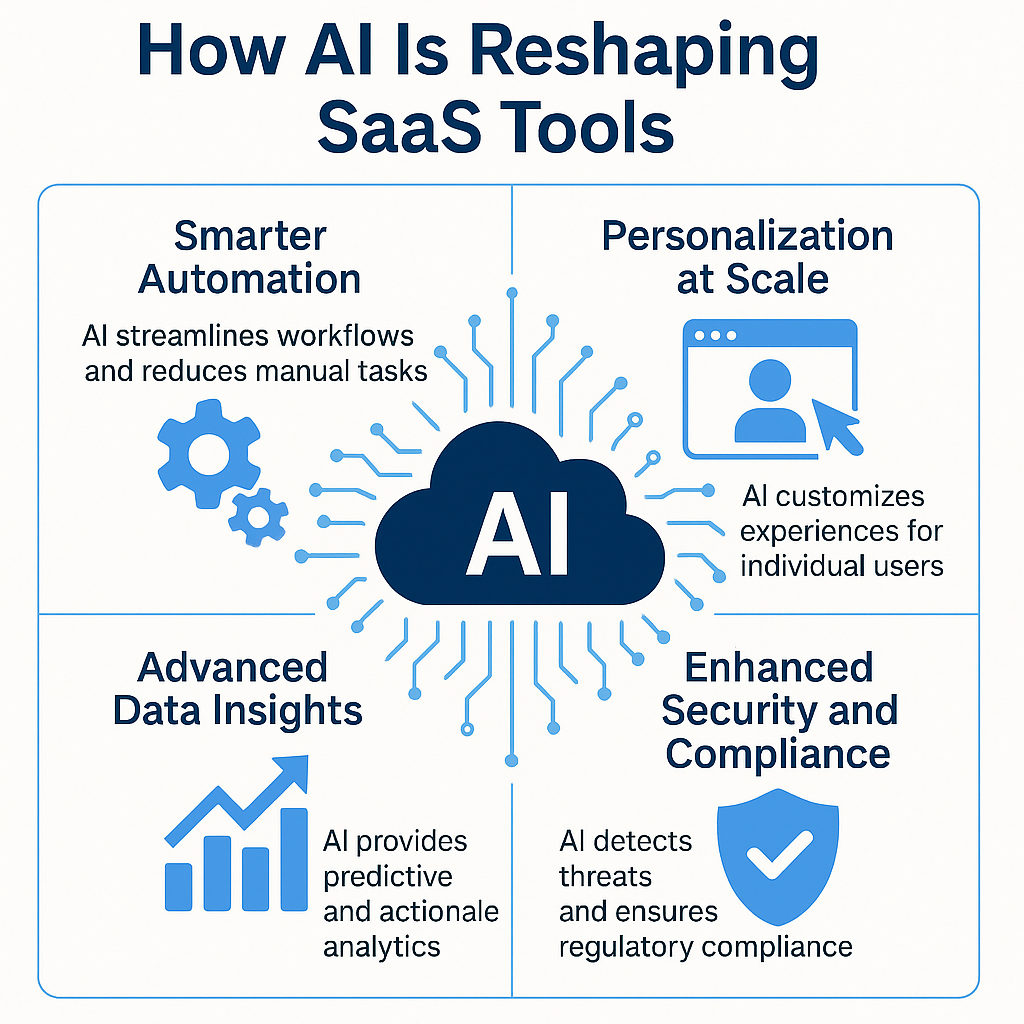
Introduction
Software-as-a-Service (SaaS) has already revolutionized the way businesses and individuals use software. Instead of purchasing bulky licenses and installing programs on local machines, SaaS delivers applications directly over the cloud—scalable, affordable, and accessible from anywhere. Now, a new wave of innovation is transforming SaaS yet again: Artificial Intelligence (AI).
AI is no longer a futuristic add-on—it’s becoming the backbone of modern SaaS solutions. From automating workflows to personalizing user experiences, AI is reshaping the SaaS landscape in ways that are too powerful to ignore.
1. Smarter Automation
One of the most immediate benefits of AI in SaaS is automation. Traditional SaaS tools often require manual setup and repetitive data entry. AI changes this by enabling:
- Automated workflows: Tools like Zapier and Make (Integromat) use AI to intelligently connect apps and suggest triggers.
- Intelligent customer support: AI-driven chatbots resolve common queries instantly, reducing response times and support costs.
- Predictive task management: Project management SaaS like Asana or Monday.com can prioritize tasks automatically based on urgency and workload.
This level of automation not only saves time but also reduces human error, boosting overall productivity.
2. Personalization at Scale
Traditional SaaS platforms often provide a “one-size-fits-all” interface. AI enables personalized experiences tailored to each user’s behavior:
- Adaptive dashboards: Instead of static dashboards, AI algorithms highlight the most relevant metrics for each user.
- Recommendation engines: Just like Netflix recommends shows, SaaS platforms suggest actions, templates, or reports based on usage patterns.
- Context-aware experiences: AI can learn from user history and adjust tool settings automatically, minimizing manual customization.
This creates a stickier, more engaging user experience that keeps customers loyal.
3. Advanced Data Insights
Data has always been the foundation of SaaS, but AI turns raw data into actionable intelligence:
- Predictive analytics: CRMs like Salesforce Einstein use AI to predict customer churn, upsell opportunities, and sales forecasts.
- Natural language queries: Tools like Power BI now allow users to type questions in plain English (“Which product had the highest sales last quarter?”) and get instant answers.
- Anomaly detection: Finance SaaS tools use AI to spot unusual spending patterns, reducing fraud risk.
With AI, businesses no longer need large teams of analysts—insights are generated instantly.
4. Enhanced Security and Compliance
Security has always been a concern for SaaS providers. AI brings proactive protection by:
- Detecting suspicious login patterns to prevent account breaches.
- Using machine learning to identify malware or phishing attempts before they spread.
- Automating compliance monitoring, ensuring that data handling aligns with regulations like GDPR or HIPAA.
This AI-driven security layer builds trust with users and strengthens the credibility of SaaS providers.
5. Cost Optimization for Businesses
AI doesn’t just make SaaS tools smarter; it makes them more cost-efficient:
- Dynamic resource allocation: Cloud-based SaaS platforms use AI to scale resources up or down automatically, reducing unnecessary costs.
- Usage-based recommendations: Tools can analyze subscription usage and recommend cost-saving adjustments.
- Automated financial forecasting: AI-powered SaaS helps companies plan budgets more accurately, reducing waste.
Businesses end up saving money while getting more value from their SaaS investments.
6. AI + SaaS = Micro-SaaS Boom
Another trend emerging from AI is the rise of micro-SaaS—smaller, highly focused SaaS products built around specific needs. Thanks to AI APIs (like GPT models, image recognition, and voice processing), solo founders and small teams can create niche SaaS tools quickly and affordably.
For example:
- AI transcription SaaS for podcasters.
- AI resume scanners for recruiters.
- AI-powered design tools for freelancers.
This democratization of SaaS is fueling innovation at an unprecedented rate.
7. Future Outlook: Where AI-Driven SaaS Is Heading
Looking ahead, SaaS tools will become:
- More conversational: Users will interact with SaaS tools through natural language, voice, or chat interfaces.
- Self-optimizing: SaaS platforms will learn from performance data and improve themselves without developer intervention.
- Hyper-integrated: AI will make SaaS ecosystems more connected, eliminating silos between apps.
The ultimate vision? SaaS platforms that feel less like “tools” and more like intelligent digital teammates.
Conclusion
AI is not just an add-on to SaaS—it’s reshaping the entire industry. From smarter automation and personalization to security and cost savings, AI-powered SaaS tools are making businesses faster, leaner, and more competitive.
As AI continues to advance, SaaS will move beyond simple applications and become autonomous systems that anticipate needs, solve problems, and drive growth. The companies that embrace AI in SaaS today will be the ones leading the digital economy tomorrow.
